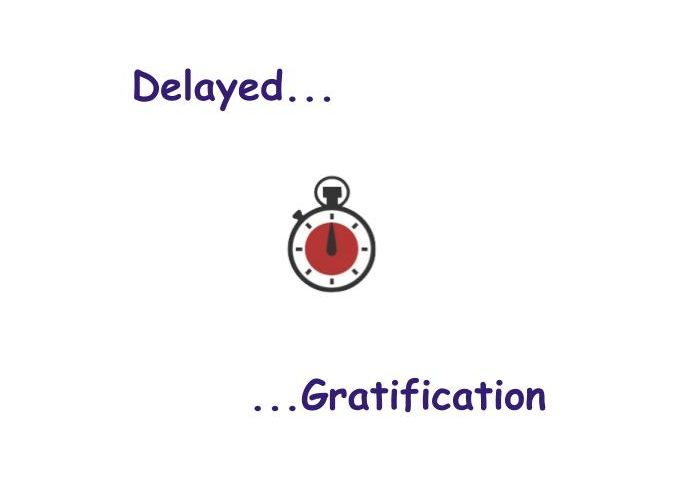
Written on April 5th, 2018 10 minute read
Delayed… Gratification
Everyone has trouble delaying gratification, but some people have it worse than others.
Let’s explore why it’s so hard, and how it connects to your success.

Part 1: It’s not (totally) your fault
Our brains are wired to favor immediate reward.
Two Million years ago, our only priority was to stay alive. Cavemen didn’t have time to sit around and contemplate life (sorry Aristotle!), instead they needed to hunt and gather. Our human brains encouraged this behavior through a short-term feedback loop, which worked really well. This simple system was at the root of our survival; don’t be eaten, successfully procreate, and improve living conditions.
While humans have evolved and developed the ability to rationalize, our brains continue to use the same decision-making system.
It’s as if we have the newest iPhone, but it’s running on the original Mac software.

Using fMRI machines, scientists can observe what is going on in our brains while we make decisions. Ultimately, it’s a fight between two parts of your brain; emotional vs. rational.
When we choose immediate gratification, our emotional parts are in control; when we choose future rewards, our rational parts are running the show. (Brain Battles, 2004).

This explains why, when we’re under stress, we tend to break goals and indulge in bad habits. Stress basically numbs our prefrontal cortex and gives complete control to the amygdala.
That’s our fight or flight mechanism, and, when that’s in control, the fighters take new shape. (The amygdala and decision making, 2010).
It’s like emotional morphs into Muhammed Ali, while rational downgrades into a nostalgic childhood geek.
Place your bets.
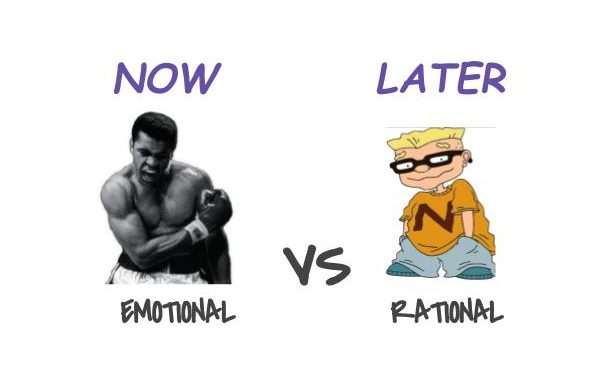
But there’s a greater issue.
Today’s world is significantly different than that of our ancestors; our goals are at odds with our brains.
Want to get in better shape?
- Work-out daily, become lean months later
Want to start a business?
- Operate on annual losses, see profit years later
Want to be more financially independent?
- Save and invest for decades, have enough to retire comfortably later in life
We’re in a constant fight against immediate reward, and our ability to overcome it is extremely predictive of future success.
This is especially true in the 21st century, but, before we apply it to our lives today, let’s take a quick look back on history.
Part 2: Human time dilation and relativity
Time dilation is a scientific concept discovered in 1897 by Joseph Larmor (source). Time dilation occurs when two people are looking at the same event but observe a different amount of elapsed time.
When this gets discussed in the scientific community, it’s focused around velocity and gravitational fields. For example, when we are on Earth we look out into the universe and view things in “Earth-time,” which is based on our gravitational field. If we were on Mars, we would see the exact same events, but happening slightly slower. This is because the gravitational field on Mars is different, and, therefore, time moves at a different speed.
Have you seen the movie Interstellar?
The scene below is touted by some astrophysicists as one of the best visual representations of time dilation ever. In this scene, part of the team spends less than 15 minutes on a high-gravitational planet. When they return back to their ship, 23 years has passed for the crew members who remained on board.
I posit this is happening everyday, all around us.
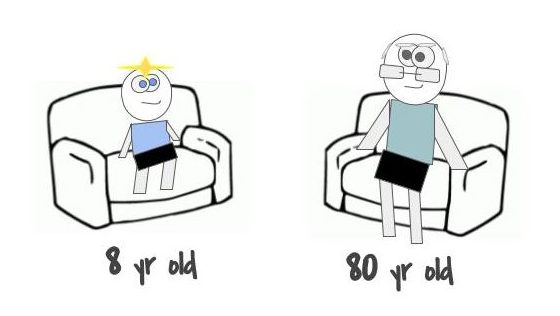
…

Instead of velocity and gravity, it’s based on our experiences and use of technology.
Here’s what I mean:
The technology we use has subtly established new baselines for our expectations and our patience.
This change began a few centuries ago, but it is progressing. Quickly.
Months: In the 1600s, when settlers first arrived in America, they set up a monthly horseback post between New York and Boston [1]. Back in that time, that was the speed of communication and exploration; it was their reality. Think about it, not only did they wait months to receive messages by post, but it took them months to sail across the ocean and arrive in America. Their reference point for time was in months, basically the currency or units of exchange.
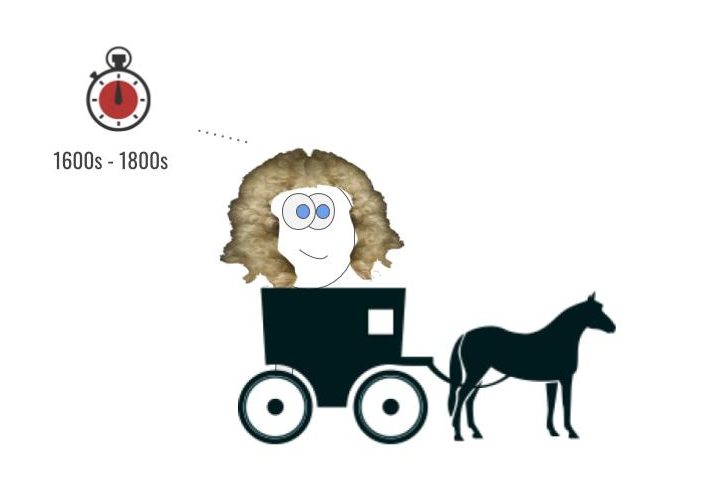
Days: Once the United States Postal Service was established in 1775, improvements in infrastructure allowed mail to be delivered on a more regular basis. By the 1800s, Americans were becoming used to receiving new mail each day, a vast improvement from the century before. With this improvement, the new baseline shifted from monthly to daily.
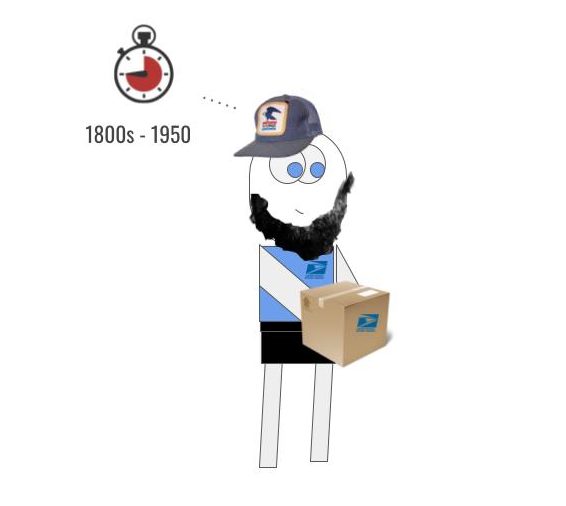
Hours: In the late 1800s, Alexander Graham Bell figured out a way to transmit sounds over wires, creating the landline telephone [2]. While the invention occurred in the 1800s, consumer adoption didn’t start taking hold until the 1960s [3]. With a telephone in every home and office, it was expected that you’d be able to answer or return a call within a few hours of receiving one. What was also widely popular around this time? The color television and the evening news. These technologies helped create a new world, one understood by the hour.

Minutes: Ray Tomlinson is credited with inventing email in 1972 [4], but it wasn’t until the 1990’s when email became more adopted by everyday people. Likewise, microwaves become common in every home, which meant one great leap; foods that were meant to take an hour to cook, would now be ready in minutes. Children born in the 90’s are also referred to as the “Microwave generation” for this reason. Kids growing up at this time naturally saw the world through minutes, and would now be able to have another basic need even faster than their parents.
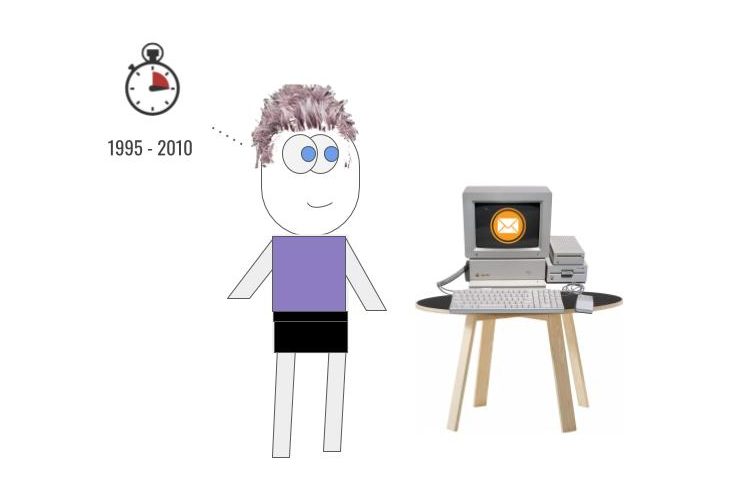
Seconds: Steve Jobs. Just by saying his name, you likely pictured two things; iPhones and black turtlenecks. We can credit him with the proliferation of smartphones, and along with those, improvements in mobile apps, sites and tools. A few seconds, can feel like an eternity. And if you need proof of this point, 53% of mobile users abandon sites that take longer than 3 seconds to load [5]. Today, for better or worse, the baseline is seconds.
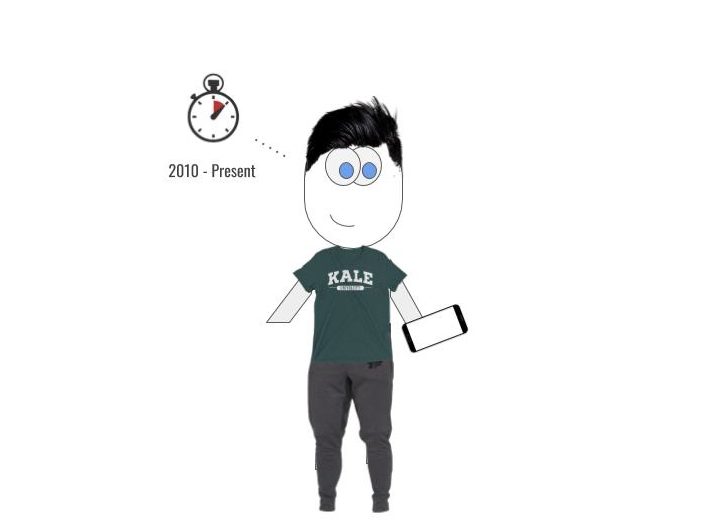
The baseline leaps between generations continues to accelerate.
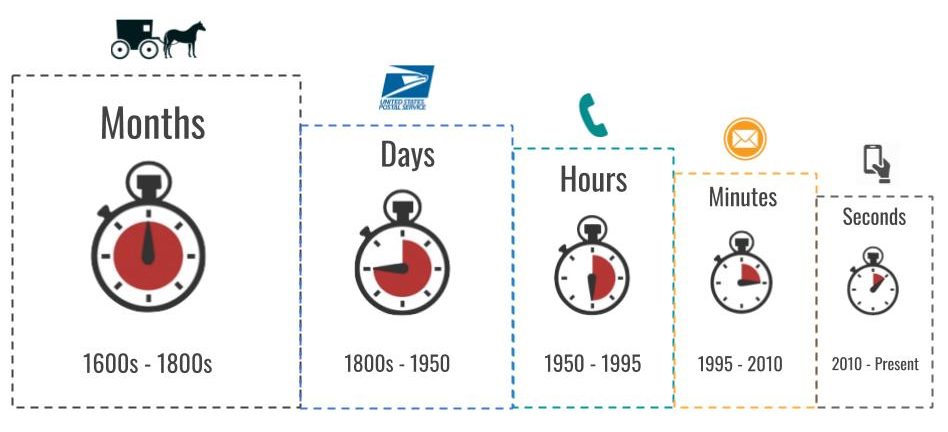
The boxes are getting smaller and the clocks are halvening. Improvements are taking less time to develop and, when they go into production, their addition is exponential.
Consider how often you may check social media after you’ve added a post, or how often you refresh your inbox after an important email has been sent. Do you think of it in months, days, hours, minutes, or seconds? The sheer speed we now have has changed our definition of delayed gratification; time has recalibrated.
Which takes us back to our kid and grandparent graphic; same reality, different baselines.

Your baseline is highly predicated on the way you choose to use the technology available. If you allow it to control your expectations and understanding of speed, you will continue to have difficulty delaying gratification.
And, gratification, is where this all comes together.
Part 3: Where everything comes together
Our greatest pursuits are set on long time horizons.
The more ambitious the goal, the longer you must persist without immediate results.
Perhaps this is one reason why we look at wildly successful individuals as if they are cut from a different cloth. It’s as if they possess some sort of magical power to accomplish remarkable things, meanwhile, we are merely “average.” Yet, fundamentally, they are more masterful at delaying gratification. A small part may be in their genes, but I’d posit it’s mostly hard-work, focus and comfort when waiting to reap reward.
The Reward Delayed Timeline
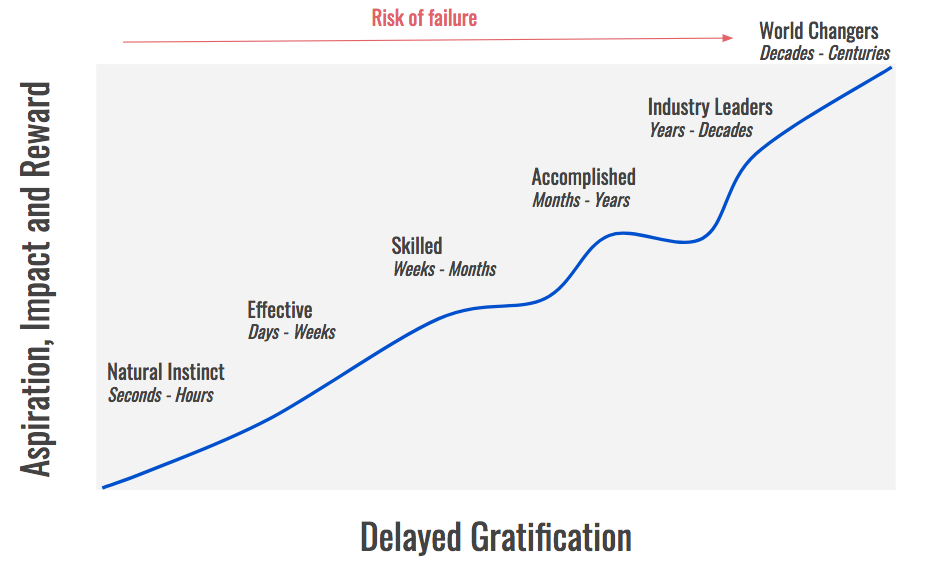
They are achieving goals that have longer reward delays. As their ambition and impact increase so do the stakes and risk. Are they immune to reality and natural stress? Certainly not. They stay grounded and honest to the necessary waiting period needed to get the job done. By surrounding themselves with others who are similar, it makes goals feel more possible and recalibrates their natural baseline to a new timeframe.
More delayed gratification = more ambitious goals
“The first order thought of instant gratification is a crowded path, ensuring mediocre results at best. Delayed gratification, which requires second order thinking, is less crowded and more likely to get results.”
A simple example would be writing this article. Believe it or not, this article took two months to complete. That meant opening a Google Doc hundreds of times, only to see incomplete or partial work. The writing too underdeveloped so I couldn’t share my work for feedback. I was forced to wait.
Here’s the thing, if I had to plot it on the Reward Delayed Timeline, it’s not that high; it falls somewhere around “Skilled.” It’s measly compared to a founder starting a business (Industry Leader) or a personal favorite of mine, Elon Musk (World Changer). Getting humanity to Mars is at least a 30 year project, which has minimal feedback loops along the way. That’s some serious second order thinking.
How to elevate your second order thinking
Step 1: Determine your most ambitious goal
- Print a copy of Reward Delayed Timeline (download here)
- Plot your top 2 or 3 aspirations on the chart
Step 2: Ask the questions
- Are your reward expectations sitting on the right time horizon?
- If not, either adjust your goal or reset time expectations
- Work backwards, set micro-goals that prove you’re progressing
Step 3: Commit to to the delay
- Whenever you feel down on yourself, pull out your timeline
- Remind yourself how ambitious your goal is, and at what delay level you committed to.
You can do it.
Repeat, repeat, repeat.
Anyone can change the world, but it takes patience
As our baseline shifts, it becomes harder to stay on task, delay results, and produce deep meaningful impact.
I believe that if you can put your phone down and detach more often, you’ll be better at setting time-delayed goals and sticking to them. By focusing your efforts on a reward-delayed timeline strategy, you can correctly plot the ambition, skills and patience needed to get the job done.
Because once you become a master of yourself, you can master anything.
And that’s Delayed…
..
Gratification
…
..
at its finest.
This writing is a new look at an old problem. Thanks! I will be sharing this!
Hey very nice site!!
I am happy to find a lot of useful information here in the post, we need work out more techniques in this regard, thanks for sharing.
Thanks for blogging this subject!
Never quit reaching. Succeed!
Impressive job!